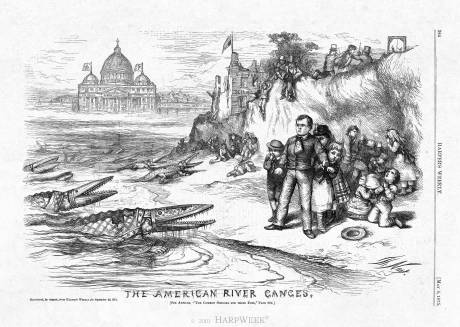
The American River Ganges by Thomas Nast (Originally published 1875- Source: HarpWeek Cartoons)
As New York and Philadelphia prepare for the Pope’s arrival, perhaps it is a good thing that famed cartoonist Thomas Nast is no longer wielding his acid-dipped pen. Or that Samuel F.B. Morse is not the Mayor who rolls out New York’s papal red carpet
Best known for his attacks on Tammany Hall, Nast was virulently anti-Catholic and anti-immigrant. One of his most notorious illustrations depicted crocodiles emerging from “The American River Ganges” with mouths formed of bishop’s miters and wearing Catholic vestments. (Above)
Back in 1836, Morse –not yet famous or wealthy as the man behind the telegraph and the code that bears his name—was a prominent portrait painter who also taught at New York University. That year, Morse ran for Mayor of New York as the Nativist candidate, believing that “Popery” was a “system of the darkest political intrigue and despotism.”
Morse’s anti-Papist feelings had apparently been heightened during a visit to Rome when the American painter refused to doff his hat as the Pope passed and a Vatican guard knocked it to the ground.
Samuel Morse did not win City Hall in 1836. But it was not due to the virulence of his anti-Catholic, anti-immigrant positions. In fact, these were widely held popular views across much of nineteenth-century America. The belief then was that Catholics, and specifically the waves of Irish immigrants, would destroy American democracy and turn the country over to the Pope who would occupy a new Vatican to be built in Cincinnati. That was not a fringe view but a mainstream notion preached in prominent pulpits by such men as Lyman Beecher, father of Henry Ward Beecher and Harriet Beecher Stowe.
This anti-Catholic venom was an accepted American truism long before the nation’s birth –a deep sectarian divide with roots in Europe’s deadly wars between Catholic and Protestant. The hatred of all things Roman Catholic was part of America’s Puritan and Protestant roots.
But the fear and loathing of Catholics went beyond sermons. It had led to some notable violence. In 1806, a New York Nativist gang attacked worshippers leaving church after midnight mass on Christmas Eve. In what became known as the “Christmas Riots,” the Irish Catholics fought back the next day in a skirmish that left a city watchman dead and led to Nativist reprisals on Irish neighborhoods.
And it was not just New York. The Ursuline convent outside Boston was attacked and burned in 1834. 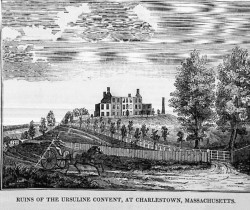
In 1844, Philadelphia saw anti-Catholic, anti-Irish hatred boil over in the Bible Riots that left dozens dead and churches and homes in flames.
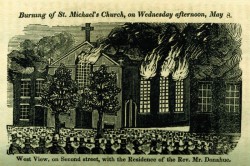
“A Full and Complete Account of the Late Awful Riots in Philadelphia”: Burning of St. Michael’s Church, on Wednesday afternoon, May 8
Historical Society of Pennsylvania
Waves of Irish immigrants later transformed New York’s politics. William Tweed would use their votes to secure power for Tammany Hall and himself. But the growth of Irish Catholic power in New York only deepened ancient animosities.
New York’s virulent anti-Catholic sentiment peaked most violently with the largely overlooked “Orange Riots” of 1870 and 1871. In the first of these, Irish Protestants marched in celebration of the July 12, 1690 victory of the Protestant King William III over Catholic King James II at the Battle of the Boyne. Taunting Irish Catholic workmen as they paraded up Eighth Avenue, the Protestant “Orangemen” went to a park where a pitched battle ensued. Eight people died.

The Orange Riot of 1871 as depicted in Frank Leslie’s Illustrated Newspaper. The view is at 25th Street looking south down Eighth Avenue (Source Wikipedia: https://en.wikipedia.org/wiki/Orange_Riots#/media/File:Orange_Riot_1871_crop.jpg)
An “Orange Day” march planned in 1871 was nearly banned. But prominent businessmen and cartoonist Thomas Nast objected vehemently to this affront to Protestant rights. With Boss Tweed guaranteeing protection for the marchers, the 1871 parade stepped off, guarded by some 5,000 policemen and National Guard militia units. Almost immediately, the marchers were pelted with bottles, bricks, shoes and stones. Pitched battles continued along the parade route. When it was over, the rioting and street-fighting left sixty people dead, most of them Irish Catholic laborers as well as three Guardsmen.
The bloodshed of the successive “Orange Riots” and Tweed’s failure to secure the parade were crucial factors in the demise of his stranglehold on New York. The city’s newspapers and largely Protestant-controlled business and financial world turned on him. Tweed was deposed, eventually arrested and later convicted of corruption.
The deep enmity towards Catholics was alive and well when John F. Kennedy ran for president in 1960. He confronted questions of his faith in a memorable speech in Texas.
I believe in an America where the separation of church and state is absolute, where no Catholic prelate would tell the president (should he be Catholic) how to act, and no Protestant minister would tell his parishioners for whom to vote; where no church or church school is granted any public funds or political preference; and where no man is denied public office merely because his religion differs from the president who might appoint him or the people who might elect him.
But that did not stop New York’s most prominent Protestant voice, Norman Vincent Peale, from opposing him. Peale had very few positive thoughts about Kennedy’s faith. Working with Billy Graham and other Protestant clergy, Peale vigorously sought to defeat Kennedy –solely on the basis of his Catholic faith. “Faced with the election of a Catholic,” Peale was quoted in Newsweek, “our culture is at stake.”
As the Pope makes what will be a largely celebratory visit to New York –where almost everyone now pretends to be Irish for a day honoring the patron saint who brought Catholicism to Ireland – these reminders of America’s dark anti-Catholic past are an important corrective. The Pope’s sojourn in the Big Apple comes as the question of religion has been thrust into the political spotlight again. Republican contender Ben Carson told NBC’s “Meet the Press” that Islam was “not consistent with the Constitution.”
Once upon a time in America, it was Catholics whose faith was the sinister religion that Americans feared. The Pope, not the Ayatollah, was the threat to American democracy.
So welcome to America, Pope Francis. Say hello to the Statue of Liberty where we still talk a pretty good game about those “huddled masses yearning to breathe free.”
The subject of America’s anti-Catholic history is treated 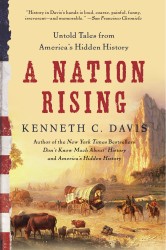 in my books America’s Hidden History and A Nation Rising.
in my books America’s Hidden History and A Nation Rising.
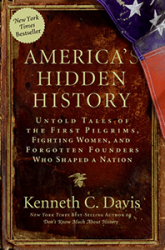
America’s Hidden History, includes tales of “Forgotten Founders”